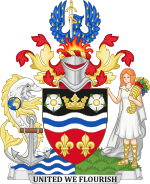
Back Humberside Welsh Humberside German Humberside Esperanto Humberside French Humberside Italian 험버사이드주 Korean Humberside Polish Хамберсайд Russian Humberside SIMPLE Humberside Swedish
| Humberside | |
|---|---|
 Humberside within England in 1991 | |
| Area | |
| • 1974 | 867,755 acres (3,511.68 km2)[1] |
| Population | |
| • 1973 | 847,230[2] |
| • 1981 | 843,280 |
| • 1991 | 858,040 |
| History | |
| • Origin | Humber Estuary and environs |
| • Created | 1974 |
| • Abolished | 1996 |
| • Succeeded by | |
| Status | Non-metropolitan county |
| ONS code | 27 |
| Government | Humberside County Council |
| • HQ | Beverley |
| • Motto | United we Flourish |
 Coat of arms of the county council | |
Humberside (/ˈhʌmbərsaɪd/) was a non-metropolitan and ceremonial county in Northern England from 1 April 1974 until 1 April 1996. It was composed of land from either side of the Humber, created from portions of the East Riding of Yorkshire, West Riding of Yorkshire, and the northern part of Lindsey, Lincolnshire. The county council's headquarters was County Hall at Beverley, inherited from East Riding County Council. Its largest settlement and only city was Kingston upon Hull. Other notable towns included Goole, Beverley, Scunthorpe, Grimsby, Cleethorpes and Bridlington. The county stretched from Wold Newton at its northern tip to a different Wold Newton at its southernmost point.
Humberside bordered North Yorkshire to the north and west, South Yorkshire and Nottinghamshire to the south-west, and Lincolnshire to the south. It faced east towards the North Sea.
On 1 April 1996, Humberside was abolished, and replaced with four unitary authority areas: North Lincolnshire, North East Lincolnshire, Kingston upon Hull, and East Riding of Yorkshire.[3] The name has continued in use as a geographical term, mainly in the media, and in the names of institutions such as Humberside Police and Humberside Fire and Rescue Service. These institutions did not change their names mainly due to costs. There were proposals to merge the police force with other Yorkshire forces and then change all the forces' names accordingly.[4] However, these proposals were later ruled out.[5]
Humber Enterprise Zone was launched in 2012 to encourage industrial development at 16 sites around the estuary.[6]
- ^ Local government in England and Wales: A Guide to the New System. London: HMSO. 1974. p. 60. ISBN 0-11-750847-0.
- ^ Registrar General's annual estimated figure mid 1973
- ^ "The Humberside (Structural Change) Order 1995". Archived from the original on 14 February 2009.
- ^ "South Yorkshire Police Force Teams Set to Merge". The Star. Retrieved 17 November 2014.
- ^ "Police merger ruled out". Rotherham Advertiser. 25 February 2015. Retrieved 27 December 2023.
- ^ "£200m boost to Humber economy launched". Insider Media. 2 April 2012. Retrieved 12 March 2015.